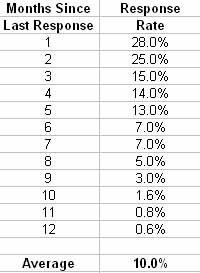This is a multi-part series, see: Part 1 – Part 2 – Part 3 – Part 4 – Part 5
In Part 2, we looked at a typical marketing productivity problem in B2C commerce. In that environment, people generally look at the overall response rate to a retail campaign instead of breaking response into meaningful behavioral segments. For example, often a 10% response rate can be distributed like this (a customer can be in only one segment):

From a marketing productivity perspective, this is tremendously important information. If the segments above are all roughly the same size, that means there was as much spent on the “1 month” segment to generate a 28% response rate as was spent on the “12 month” segment to get a .6% response rate.
Does that make any sense to you? In fact, the vast majority of the spend in the out months is completely wasted, isn’t it?
Add to this the fact that the segments in the “out months” are typically bigger than the segments in the “close months”, and you get a real mess in the marketing productivity area.
This is the Customer LifeCycle at work. As each month slips by, most customers fall into the next lower monthly level, and they become even less responsive at each level on the way down. If you do nothing, they continue down this “stack” of levels until they simply do not respond to anything.
Many people think that sending out a monthly e-mail promotion is retention marketing. I see this talked about everywhere. But promotions are not targeted by LifeCycle behavior, as true retention marketing always is. In retention marketing, you want to tailor the offer to the stage of the LifeCycle the customer is in, the level they are in the stack. The objective is to keep cycling as many customers as you can into the upper levels of the stack, where they are more likely to respond to promotions.
That’s how Promotions and Retention are different but work together; retention activity drives higher response to promotional activity.
If you’re pleased by the ROI you get with your promotional stuff, wait until you see what targeting by LifeCycle segment delivers – the double whammy of reduced defection and higher response rates to promotion.
So what’s a smart, productivity inclined marketer to do? You want to slow down this “falling through the levels” process, you want fewer customers falling into the next lower level each month. That means you have to design more compelling and more effective marketing programs to slow them down.
But where does the budget for the testing and new, more effective campaigns come from?
It comes from the budget you are simply flushing on the very low response rate customers. You reallocate much of that part of the budget “back to the top” so you can really work as hard as you can to counteract the effects of the Customer LifeCycle.
At the same time, as suggested previously, you should start testing acquisition programs against the non-responsive “customers”.
You need to culturally change the mindset here. These low responder groups are not acting like customers anymore, yet you are continuing to treat them like customers. However, since the vast majority don’t act like customers anymore, you end up not talking with them, but talking at them. You are not providing the messaging they need to hear to change their behavior.
On the other hand, these groups are fantastic acquisition targets because they have interacted with you before. Market to them like acquisition targets and you will be more successful in getting them to respond.
Realize, however, that even though they are “old customers”, their behavior is going to be like a new customer. They are starting at the top of the LifeCycle stack again, and will just start dropping down level by level all over again. So you should be prepared to catch them in your shiny new retention net.
The key to profitable retention programs is to act early in the defection process. “Win Back” is too late, the ROI is going to be weak because it takes so much force to overcome a defection that has already taken place.
Can you see why retention can’t possibly be efficient as an “annual” program, as some companies treat it? It’s out of synch with the LifeCycle. In an annual program, you have people who have not responded in a year and people who have not responded in 3 months. But these people will behave differently, so you just get the same kind of “stack” as above, with no one segment optimized for ROI.
Rather, you want to find the place in that stack that generates the highest level of profitability for your retention programs. And then you want to hit everybody who falls to that level when they get to that level, every month like clockwork. Event-triggered retention.
Going beyond the “one level” idea above, for each level, there is a different marketing campaign or technique that will provide the highest ROI against that segment.
Your mission is to test and find out what these different campaigns are. The right message to the right person at the right time. If B2C commerce is your thing, start out testing your levels by exploring the Discount Ladder test.
Go to Part 4: Now, let’s apply the same thought process (but use different metrics) to B2B and service businesses.
or
Get the book at Booklocker.com
Find Out Specifically What is in the Book
Learn Customer Marketing Concepts and Metrics (site article list)
Download the first 9 chapters of the Drilling Down book: PDF